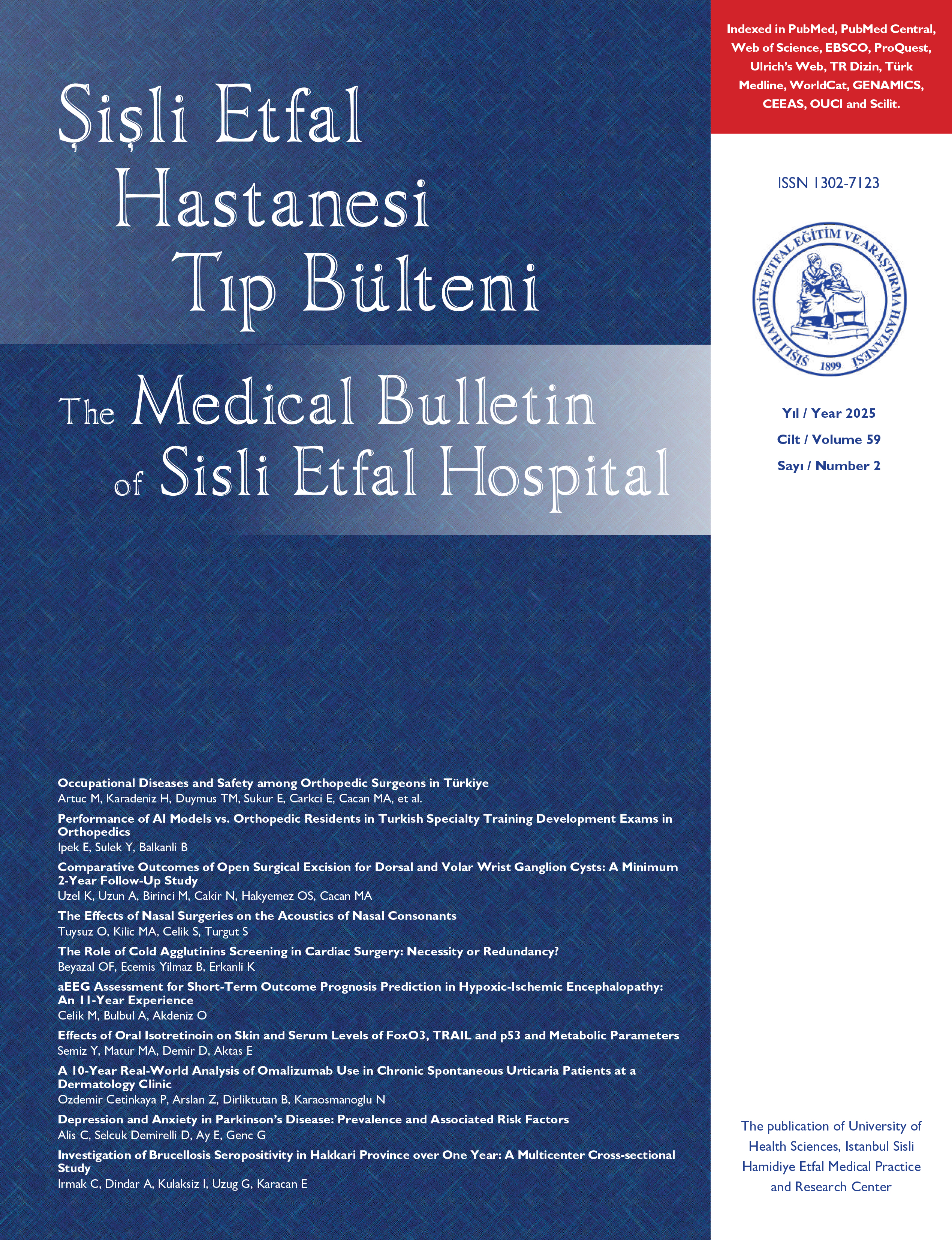
Tip 2 diyabetes mellitus tanısında hemoglobin A1cnin oral glukoz tolerans testi ve açlık plazma glukozu ile uyumu
Elif Guven Cetin1, Nazan Demir1, Kubra Kalkan2, Yuksel Asli Ozturkmen1, Perin Nazif3, Sumeyra Yildirim Yucelen4, Aslihan Calim1, Fatih Borlu1, Yuksel Altuntas51Department of Internal Medicine, University of Health Sciences Turkey, Sisli Hamidiye Etfal Training and Research Hospital, Istanbul, Turkey2Department of Internal Medicine, Istanbul Bakirkoy Dr. Sadi Konuk Training and Research Hospital, Istanbul, Turkey
3Department of Nephrology, University of Health Sciences Turkey, Sisli Hamidiye Etfal Training and Research Hospital, Istanbul, Turkey
4Department of Internal Medicine, Acibadem Kadikoy Hospital, Istanbul, Turkey
5Department of Endocrinology, University of Health Sciences Turkey, Sisli Hamidiye Etfal Training and Research Hospital, Istanbul, Turkey
Giriş: Diyabetes mellitus (DM) sürekli tıbbi bakım gerektiren, kronik bir metabolizma hastalığı olup prevelansı dünya çapında giderek artmaktadır. Prediyabet ve diyabetin erken tanısı, yol açtığı mortalite, morbidite ve bunların getireceği maliyet göz önüne alındığında önem teşkil etmektedir. DM tanısında altın standart olarak kabul edilen oral glukoz tolerans testinin (OGTT) uygulamadaki zorlukları ve tekrarlanabilirliğinin güç olması nedeniyle daha kolay uygulanabilir tanı testlerine ihtiyaç duyulmaktadır. Bu çalışmada hemoglobin A1cnin (HbA1c) Türk toplumunda diyabet ve prediyabeti öngörmedeki geçerliliğinin anlaşılması, HbA1cnin diğer diyabet tanı testleri ile olan uyumunun değerlendirilmesi amaçlanmıştır.
Yöntem ve Gereçler: 01.01.2013 ile 30.06.2014 tarihleri arasında Sağlık Bilimleri Üniversitesi Şişli Hamidiye Etfal Eğitim ve Araştırma Hastanesi iç hastalıkları polikliniği ve endokrinoloji polikliniğine başvurmuş, bilinen diyabet ve prediyabet tanısı olmayan, 18 yaşından büyük hastalar çalışmaya dahil edilmiştir. OGTT yapılmış, açlık plazma glukozu (APG) ve HbA1c düzeyi ölçülmüş olan kişiler retrospektif olarak taranarak, OGTT ve APG ile HbA1c sonuçları arasındaki uyum araştırılmıştır.
Bulgular: Dışlama kriterlerine uyan 127 kadın, 74 erkek toplam 201 kişi çalışma grubuna alınmıştır. Ortalama yaş 49,3±10,4 olarak hesaplanmıştır. HbA1c, olguların %15inde < %5.7, % 60ında %5.7-6.4 arasında, %25inde ≥%6.5 saptanmıştır. Katılımcıların %24ünde APG <100 mg/dL iken, %71inde 100-126 mg/dL arasında, %5inde ise ≥126 mg/dL olarak bulunmuştur. OGTT verilerine göre olguların %23ünün sağlıklı, %59unun prediyabetik, %18inin ise diyabetik olduğu görülmüştür. HbA1cnin sensivitesi ve spesifitesi sırasıyla %50 ve %80 olarak hesaplanmıştır. Açlık plazma glukozunun sensivitesi %17, spesifitesi ise %97 saptanmıştır.
Sonuç: Çalışmamızdan elde ettiğimiz veriler DM tanısında HbA1cnin, APGye göre daha duyarlı bir test olduğunu göstermektedir. Prediyabet ve DM tanılarına yönelik HbA1c kesim noktalarının yeniden tanımlanması ve tanı kılavuzlarının bu doğrultuda revize edilmesi için ulusal/uluslararası ölçekte daha geniş katılımlı, prospektif çalışmalara ihtiyaç vardır. (SETB-2018-10-149)
Anahtar Kelimeler: Diyabetes mellitus, hemoglobin A1c, oral glukoz tolerans testi, açlık plazma glukozu
The Compatibility of Hemoglobin A1c with Oral Glucose Tolerance Test and Fasting Plasma Glucose
Elif Guven Cetin1, Nazan Demir1, Kubra Kalkan2, Yuksel Asli Ozturkmen1, Perin Nazif3, Sumeyra Yildirim Yucelen4, Aslihan Calim1, Fatih Borlu1, Yuksel Altuntas51Department of Internal Medicine, University of Health Sciences Turkey, Sisli Hamidiye Etfal Training and Research Hospital, Istanbul, Turkey2Department of Internal Medicine, Istanbul Bakirkoy Dr. Sadi Konuk Training and Research Hospital, Istanbul, Turkey
3Department of Nephrology, University of Health Sciences Turkey, Sisli Hamidiye Etfal Training and Research Hospital, Istanbul, Turkey
4Department of Internal Medicine, Acibadem Kadikoy Hospital, Istanbul, Turkey
5Department of Endocrinology, University of Health Sciences Turkey, Sisli Hamidiye Etfal Training and Research Hospital, Istanbul, Turkey
Objectives: Diabetes mellitus (DM) is a chronic metabolic disease requiring lifelong medical care, and its prevalence is increasing worldwide. Early diagnosis of prediabetes and diabetes is significant in view of the mortality, morbidity and cost associated with them. Because of the difficulties in application and reproducibility of oral glucose tolerance test (OGTT), which is considered to be the gold standard in the diagnosis of DM, more feasible diagnostic tests are needed. This study aims to evaluate the validity of hemoglobin A1c (HbA1c) in predicting prediabetes and diabetes in the Turkish population and to evaluate the compatibility of HbA1c with other diagnostic tests.
Methods: The patients who were admitted to Health Sciences University Sisli Hamidiye Etfal Training and Research Hospital internal diseases and endocrinology outpatient clinics between 01.01.2013 and 30.06.2014 enrolled in this study. The participants were >18 years of age and were not diagnosed with prediabetes or DM earlier. The results of OGTT, fasting plasma glucose (FPG) and HbA1c tests were retrospectively screened, and the correlation of them was analyzed.
Results: In this study, 201 participants enrolled. Of these cases, 127 were women and 74 were men. Mean age of the group was 49.3±10.4 years. HbA1c was observed <5.7% in the 15%, 5.7-6.4% in the 60%, and ≥ 6.5% in the 25% of the cases. While FPG was <100 mg/dL in 24% of the participants, it was found to be between 100-126 mg/dL in 71% and ≥126 mg/dL in 5% of the participants. According to the OGTT data, 23% of the cases were healthy, 59% were prediabetic and 18% were diabetic. The sensitivity and specificity of HbA1c were calculated as 50% and 80%, respectively. While the sensitivity of FPG was 17% and specificity was 97%.
Conclusion: The data obtained from our study show that HbA1c is a more sensitive test compared to FPG in the diagnosis of DM. Prospective studies with broad participation at national and international levels are needed to redefine HbA1c cut-off points for the diagnosis of DM and prediabetes. Thus, it will be possible to revise the diagnostic guidelines accordingly.
Keywords: Diabetes mellitus, fasting plasma glucose; hemoglobin A1c; oral glucose tolerance test.
Makale Dili: Türkçe



















